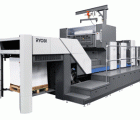
Both companies are headquartered in Hiroshima southern Japan, and cite shrinking demand in the developed world and the need to be more competitive as the drivers.
The study into the potential for a joint venture will be completed by June 30 this year.
Bernard Cheong, managing director of Ryobi’s Australia and South East Asian distributor Cyber says, “ We do not want to speculate at this point, we will wait for the official announcement. Ryobi’s sheetfed business has been growing rapidly in the recent years and it will be interesting to see what comes out of this business alliance study.”
The two have had very differing fortunes outside Japan, with Ryobi presses proving highly successful in both developed and developing print markets. In many markets including Australia they are now number two to Heidelberg in the A3 and B2 sectors. Mitsubishi in contrast, which is mainly in the B1 space, although it does manufacture B2 presses, has made virtually no impact, due in no small part to a vacillating effort on the part of its management.
Ryobi is four times the size of Mitsubishi’s Paper and Packaging division, with sales last year of Yen166bn (A$1.78bn) compared to Mitsubishi’s Yen43bn (A$460m). Ryobi made net profit of Yen4.2bn (A$45m), with Mitsubishi making Yen690m (A$7.4m). The Print & Packaging division of Mitsubishi Heavy Industry was established as a stand alone entity on July 1 2010.
Ryobi’s figures are for the group, which also includes its power tools, die casting and builders hardware businesses. Mitsubishi’s figures also include its heatset and coldest web offset and paper converting businesses, but these are not part of any proposed joint venture.
A statement by the two companies says, “As part of the further efforts in strengthening corporate structure, both companies agreed to study on establishing business alliance in the field of sheet-fed offset printing press business, with a possible set up of a joint venture company in the future specifically aiming at improving competitiveness of sheet-fed offset printing machinery, enhancing the scale of operations, and solidifying its management base.”
In the statement the two companies say that, “It is expected in the commercial printing industry that the market demand for printing machinery in the developing countries is getting stronger, and the demand for higher specification products is expected to grow further in the global market.”
Both companies are now committed to jointly study the scheme that they hope will allow significant synergies such as enhancement of product line-up, enlargement of product development capability, reduction of product cost, and improvement in sales and service networks. The plan is expected to enable the stronger presence in the global market.
The study into the proposed joint venture continues the global shake-up in the offset press world; Heidelberg has had to be rescued by government loans, manroland went into administration and was sold off as two separate slimmed down parts, KBA has downsized by 30 per cent, Shinohara has gone bust and been bought by the Chinese Hans Gronhi company, while Akiyama and Goss have both been bought out of bankruptcy protection by Shanghai Electric, all since the onset of the GFC.
Comment below to have your say on this story.
If you have a news story or tip-off, get in touch at editorial@sprinter.com.au.
Sign up to the Sprinter newsletter
